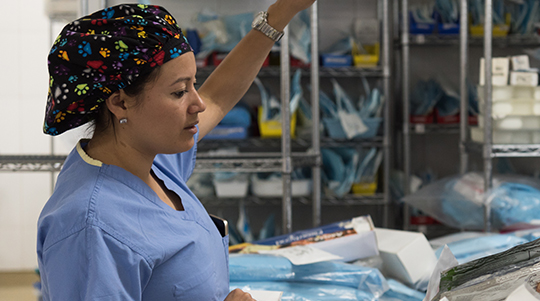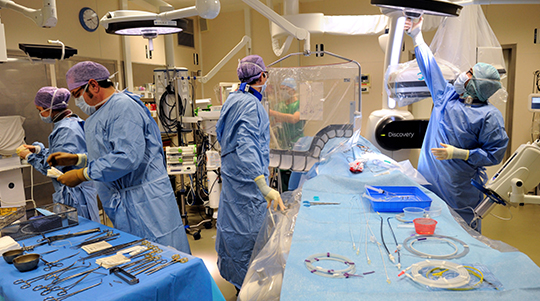5 factors for greater supply chain resiliency in the surgery center space
And how one practice matches scalability with growth

For so many people working in healthcare today, it feels like the pandemic is going on forever. Perhaps because the supply chain disruptions continue to hurt everyone from hospital systems to urgent care facilities to surgery centers. Over the last couple of decades as we struggle to improve a costly and over-burdened healthcare system, Ambulatory Surgery Centers (ASCs) are a great example of a successful transformation in patient care. And why? Because the ASC model enhances patient care by:
- Focusing on a small number of processes in a single setting, as opposed to large-scale hospital demands
- Providing quality control is centered on a smaller space
- Allowing patients a better experience with caregivers who know the patient, rather than hospital administrators who do not know the individual
This model of care is only as good as the products it has available to its patients. Having a consistent supply chain and having product available is critical for high-volume surgery centers. Due to their size and scope of operations, surgery centers not only need to manage their space but also their inventory to ensure they have what they need at the time patients come in for their procedure. Turnover time is also a key metric for surgery centers as patients do not stay overnight at the facility.
Here are five factors that can impact the resiliency of a surgery center as care points continue to shift and supply chains continue to heal.
- Standardization
Standardization of products helps to reduce waste while also making care delivery more consistent. The most effective way to realize this standardization is through custom procedure packs—leading to greater discounts, ease of control over inventory and better overall all materials management, including less waste.
- Managing operational efficiency
Beyond standardization, which is key to improving workflows and efficiency, the key to working more efficiently is to reduce time spent on administrative tasks that could be better spent on providing care. This is where front-end ordering systems, forecasting and invoice automation come save the day… or least time in your day.
SPOTLIGHT
Advanced Pain Care matches supply chain with caseload growth to drive better patient care
Advanced Pain Care (APC) is the largest pain management practice in Texas, with a staff of nearly 600 team members offer specialties that include Pain Management, Neurosurgery, Rheumatology, Behavioral Health, Addictionology, and and Neurology. APC operates 17 clinics, three surgery centers, three retail pharmacies, and a toxicology lab. Providing over 1,800 surgeries per month in their surgery centers and continuing to expand operations with new facilities, APC keeps a close eye on balancing operational efficiencies with increased costs per case.
“Operating multiple facilities over a large geographic footprint presents many challenges. Combine that with our depth of subspecialties and the challenges only become more complex.”
—Ganesh Ramoutar
Chief procurement officer at Advanced Pain Care and Advanced Surgical Centers
Together with APC, Medline provided a one-stop shop for not only all of the organization’s disposable medical supplies, but also pricing, substitution, and custom surgical packs. Operating multiple sites while being able to talk to one person and get solutions help mitigate issues and allows APC to focus on patient care. Together with Medline, APC was able to obtain pricing through aggregation with their group purchasing organization (GPO) to help the organization find critical cost savings on their medical supplies.
To balance operational efficiencies as costs per case increase, APC has turned to standardization to find success. A big part of APC’s standardization strategy is the use of custom packs. Custom packs not only contain everything needed for a specific procedure, the packs come ready for use and help clinicians save time and valuable space within the supply room.
- Clinically-acceptable versus clinically-preferred
Because of shortages during COVID-19, many clinicians were forced to use items on substitution lists that were clinically equivalent—or maybe even superior—but not on the clinician’s preference list. This is an age-old conversation between clinicians and supply chain managers about how to keep cost savings down while allowing clinicians to work with instruments and items they deem more effective. Although driven by supply chain shortages in many cases, product substitutions also give clinicians a chance to re-evaluate what they do and how they do it, potentially finding new opportunities to streamline operations, find greater operational efficiencies, and financial savings.
- Supply costs
As referenced in other areas, ASCs must have a laser focus on their supply cost. It is imperative to review every contract and take advantage of prices available through a group purchasing option (GPO). Also, there are always opportunities to manage your supply costs with the help of appropriate supply chain technologies and good inventory control processes and software. And adding reprocessed devices to your inventory not only saves you money year after year, but meets clinical needs, while achieving sustainability goals.
- Preparedness: Expect a disruption
Every surgery center’s emergency preparedness plans should be updated to include pandemic preparedness, with a section that addresses all critical supplies, and not just personal protective equipment (PPE). From natural disasters to labor strikes, it is becoming imperative to have stockpile plan, whether that means having inventory supplied in a 3PL setting or working with your supplier to have processes in place for an eventual catastrophe.
Key takeaway
ASCs have been providing outpatient surgical procedures at lower costs without sacrificing quality for decades, primarily due to their efficient operating model. When the supply chain process is managed effectively, providing resiliency to overall operations, the opportunities for cost reduction and increased revenues come into sight.
To learn more about Medline’s solutions for ASC please visit us at https://meddevod.wpdev.medline.com/about-us/who-we-serve/surgery-center.




